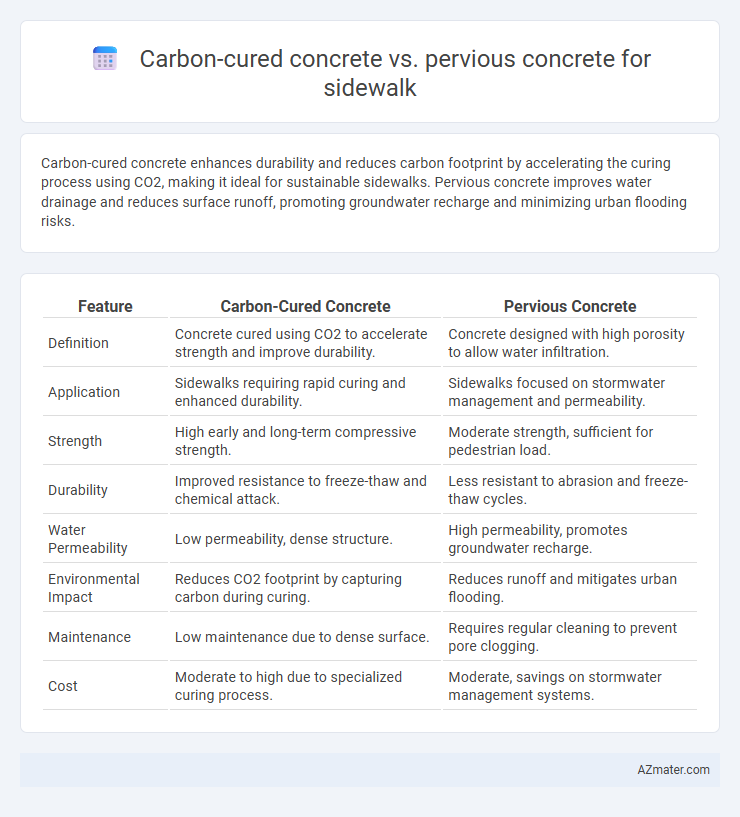Carbon-cured concrete enhances durability and reduces carbon footprint by accelerating the curing process using CO2, making it ideal for sustainable sidewalks. Pervious concrete improves water drainage and reduces surface runoff, promoting groundwater recharge and minimizing urban flooding risks.
Table of Comparison
| Feature | Carbon-Cured Concrete | Pervious Concrete |
|---|---|---|
| Definition | Concrete cured using CO2 to accelerate strength and improve durability. | Concrete designed with high porosity to allow water infiltration. |
| Application | Sidewalks requiring rapid curing and enhanced durability. | Sidewalks focused on stormwater management and permeability. |
| Strength | High early and long-term compressive strength. | Moderate strength, sufficient for pedestrian load. |
| Durability | Improved resistance to freeze-thaw and chemical attack. | Less resistant to abrasion and freeze-thaw cycles. |
| Water Permeability | Low permeability, dense structure. | High permeability, promotes groundwater recharge. |
| Environmental Impact | Reduces CO2 footprint by capturing carbon during curing. | Reduces runoff and mitigates urban flooding. |
| Maintenance | Low maintenance due to dense surface. | Requires regular cleaning to prevent pore clogging. |
| Cost | Moderate to high due to specialized curing process. | Moderate, savings on stormwater management systems. |
Introduction to Concrete Innovations for Sidewalks
Carbon-cured concrete uses captured CO2 during manufacturing to enhance strength and reduce carbon footprint, making it a sustainable option for sidewalks. Pervious concrete allows water to pass through its porous structure, improving stormwater management and reducing runoff on pedestrian pathways. Both innovations address environmental concerns while offering durable, functional surfaces tailored to urban sidewalk needs.
Understanding Carbon-Cured Concrete
Carbon-cured concrete enhances durability and reduces carbon emissions by absorbing CO2 during curing, resulting in a denser, more resilient sidewalk surface ideal for urban environments. Unlike pervious concrete, which promotes water infiltration to reduce runoff, carbon-cured concrete prioritizes structural strength and long-term sustainability. This innovative curing process contributes to carbon sequestration while maintaining the functional requirements of pedestrian pathways.
Overview of Pervious Concrete Technology
Pervious concrete is engineered to allow water infiltration through its porous structure, significantly reducing stormwater runoff and promoting groundwater recharge in sidewalk applications. Its composition typically includes a carefully controlled mix of coarse aggregates, cement, and minimal fine aggregates to create interconnected voids that facilitate permeability while maintaining sufficient strength for pedestrian traffic. This technology supports sustainable urban drainage systems (SUDS) and helps mitigate urban heat island effects by enabling water evaporation directly from the concrete surface.
Environmental Impacts: Carbon Sequestration vs. Stormwater Management
Carbon-cured concrete enhances environmental sustainability by actively sequestering carbon dioxide during the curing process, reducing greenhouse gas emissions and contributing to climate change mitigation. Pervious concrete supports environmental health through effective stormwater management, allowing rainwater to infiltrate surfaces, replenishing groundwater and decreasing urban runoff pollution. Choosing carbon-cured concrete prioritizes carbon capture benefits, while pervious concrete emphasizes water quality improvement and flood risk reduction.
Durability and Longevity in Sidewalk Applications
Carbon-cured concrete offers enhanced durability through accelerated carbonation processes that increase surface hardness and resistance to freeze-thaw cycles, making it highly suitable for sidewalk applications exposed to harsh weather. Pervious concrete provides superior longevity by allowing water infiltration, reducing surface water damage and preventing cracking from hydrostatic pressure, which helps maintain structural integrity over time. While carbon-cured concrete focuses on strength enhancement, pervious concrete excels in durability by promoting effective drainage and reducing the risk of erosion and deterioration in sidewalks.
Installation Process Comparison
Carbon-cured concrete involves curing with CO2 gas in a controlled environment, accelerating strength gain and reducing curing time to about 24-48 hours, which streamlines installation for sidewalks. Pervious concrete requires careful mixing and placement to ensure permeability, demands precise water-to-cement ratios, and necessitates special curing methods like wet curing or membrane curing over 7 days to maintain porosity. Installation of carbon-cured concrete is generally faster and more controlled, while pervious concrete requires more meticulous handling to preserve its infiltration capabilities.
Maintenance Requirements and Costs
Carbon-cured concrete offers enhanced durability by reducing carbonation rates, leading to lower long-term maintenance needs and extended lifespan compared to traditional mixes. Pervious concrete, designed for water permeability, requires regular cleaning to prevent clogging and maintain drainage efficiency, resulting in higher maintenance costs over time. Despite initial higher costs, carbon-cured concrete's reduced upkeep and structural resilience provide better value for sidewalks in urban environments with heavy foot traffic.
Safety and Performance in Urban Environments
Carbon-cured concrete offers enhanced durability and improved resistance to wear, making it ideal for high-traffic urban sidewalks by reducing surface deterioration and slip hazards. Pervious concrete excels in water drainage and stormwater management, minimizing puddles and reducing hydroplaning risks, which enhances pedestrian safety during wet conditions. Both materials promote sustainable urban infrastructure, but carbon-cured concrete prioritizes longevity and structural integrity, while pervious concrete focuses on permeability and environmental performance.
Climate Adaptability and Regional Suitability
Carbon-cured concrete offers enhanced durability and reduced carbon footprint, making it ideal for urban areas with strict environmental regulations and moderate climates. Pervious concrete excels in managing stormwater through increased permeability, suited for regions with heavy rainfall and flooding concerns. Climate adaptability favors carbon-cured concrete in stable, temperate zones, while pervious concrete suits wet climates requiring improved drainage and groundwater recharge.
Selecting the Best Concrete Solution for Sustainable Sidewalks
Carbon-cured concrete offers enhanced durability and reduced carbon footprint through CO2 sequestration, making it ideal for sustainable sidewalks seeking long-term environmental benefits. Pervious concrete improves stormwater management by allowing water infiltration, reducing runoff and urban flooding risks while enhancing groundwater recharge. Selecting the best concrete solution depends on prioritizing either carbon reduction and structural longevity or effective water management and local ecosystem support for sustainable sidewalk projects.

Infographic: Carbon-cured concrete vs Pervious concrete for Sidewalk
 azmater.com
azmater.com